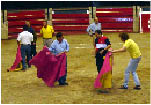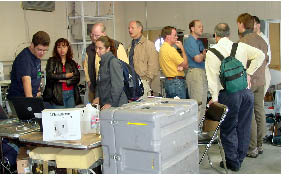The fixed “supersite” capability at
CENICA was enhanced with state-of-the-art instrumentation contributed
by many US and European teams. CENICA is housed in a building
on the Iztapalapa campus of the Universidad
Autónoma Metropolitana (UAM).
CENICA maintains its own suite of routine (EPA level) air quality
monitoring instruments for NOx,
CO, O3,
SO2,
and PM10,
and also has an automated sampling system for GC/FID analysis
of volatile organic carbons (VOCs). In addition, the automatic
monitoring network RAMA maintains two nearby air quality monitoring
sites. When not involved in mobile off-site experiments, the
mobile laboratory was sited at CENICA and its instrument suite
contributed to the supersite’s database.
During the MCMA-2003 campaign, a tall
flux tower was erected on the roof top of CENICA for continuous
micrometeorological flux measurements of carbon dioxide, water
vapor and total olefins and periodic flux measurements of NOy,
NO2,
NO, HNO3,
NH3,
H2CO,
and other trace gases using mobile laboratory fast response
sensors. The CENICA site also hosted collaborative measurements
from various US and European institutions, including i) OH concentrations
and reactivity measurements by William Brune’s team at Penn
State; ii) a GC-based peroxyalkylnitrate instrument, an open-path
near infrared ammonia vapor instrument, a Luminol chemiluminescent
instrument for semi-continuous olefin measurements, and an Andersen
Aethelometer for black carbon determinations from Jeffrey Gaffney
and Nancy Marley of the Department of Energy’s Argonne National
Laboratory (DOE/ANL); iii) nitro-PAH measurements by Roger Atkinson
and Janet Arey’s team at the University of California, Riverside;
iv) an aerosol mass spectrometer from José Jiménez’ team at
the University of Colorado; v) a proton transfer reaction mass
spectrometer (PTR-MS) and several radiometers and particle sampler
from Pacific Northwest National Laboratory (PNNL); vi) two research
lidars from Hubert van den Bergh and Valentin Simeonov’s team
at EPFL and from MIT/Free University of Berlin, and a commercial
lidar from Elight; vii) a research grade visible/near ultraviolet
differ-ential optical analysis spectroscopy (DOAS) instrument
provided by the University of Heidelberg and operated by the
MIT team; viii) mini DOAS and FTIR from Bo Galle’s team at Chalmers
University. A complete list of participating institutions is
listed in the box.
A key feature of the spring MCMA-2003
campaign was the deployment of a new mobile laboratory designed
and developed by ARI. The new ARI mobile lab is larger
and equipped with significantly more instruments than the original
version deployed for the MCMA 2002 exploratory field measurements
described in the last newsletter (Vol. 2, Fall 2002). Additional
fast response (1 s) instruments included a quantum cascade tunable
infrared laser differential absorption spectrometer (QC-TILDAS)
to measure gaseous ammonia (NH 3) from ARI, a commercial total
nitrogen oxide (NO y) from MIT, a fast response DustTrak fine
particle surface area monitor also from MIT, and a second commercial
non-dispersive infrared carbon dioxide monitor from ARI. Additionally,
slower response (10-60 s) instruments included a commercial
UV absorption SO 2monitor from Washington State University,
a commercial aethelometer on loan from the Lawrence Berkeley
National Lab, a customized gas chromatographic instrument to
measure peroxy acetyl nitrate (PAN) and related organic peroxynitrates
from DOE/ANL, and a customized impactor to collect fine particles
for subsequent synchrotr on X-ray analysis provided by PNNL.
The PTR-MS from Montana State University used for fast response
oxygenated and aromatic VOC compound measurements was successfully
reconfigured to be used in mobile mapping and vehicle chase
experiments as well as at fixed site deployments.
These additional instruments, coupled with the fast response
trace gas and fine particle instrumentation from the original
ARI mobile laboratory allowed a wide range of experiments to
be pursued during the MCMA-2003 campaign. These included selected
vehicle chase experiments to measure total nitrogen oxides,
formaldehyde, acetaldehyde, ammonia, and selected aromatic VOCs
exhaust emission ratios from heavy-duty diesel trucks, diesel
buses, colectivos, taxis, and selected light-duty trucks and
cars. We also mapped background concentrations of these and
other compounds in selected MCMA industrial, commercial, and
residential districts, paying particular attention to the area
around the CENICA supersite, where we carefully characterized
rush hour traffic emissions and detected industrial plumes of
toluene and ethyl acetate. Large plumes of ammonia, uncorrelated
with CO 2emissions, were also detected near CENICA and in other
MCMA districts. Successful fixed site deployments were made
to the Pedregal and La Merced RAMA monitoring sites and the
Santa Ana boundary site.
An initial data analysis workshop will be held at MIT in August
2003 and a second workshop to discuss the preliminary results
is scheduled for January 2004. Results of the field measurements
will be communicated to the scientific community and decision
makers through publications and conferences. It is anticipated
that the insight obtained through the field measurements and
analysis of the data will be crucial for protecting human health
and ecosystem viability in the MCMA.
More than three dozen post-doctoral associates, graduate students
and undergraduates from US and Mexican institutions were involved
in the field measurement and data analysis. Working side by
side, these researchers developed and used advanced methods
for measuring pollutant emission fluxes and ambient concentrations.
Thus, the MCMA-2003 campaign provides an excellent opportunity
to build capacity for research, education, and policy in developing
countries and contributes to international exchange.
Please visit our website on the field campaign and contact
us if you have any questions or comments at ltmolina@mit.edu
.
Jed Horne is an undergraduate Research Assistant
and Robert Slott is a Visiting Engineer with the Integrated
Program on Urban, Regional, and Global Air Pollution.
Field Campaign Photos

Field campaign participants; some who were not available during
the photo session were added electronically.

Scene from the Fiesta Mexicana Farewell Party.

Terry Shirley and Robert Lesher explaining the OH measurements
(mounted on flux tower platform) to Mario Molina.

Investigators (J. Jiménez, B. Lamb, R. Volkamer) explaining
the measurements to visitors from UNAM, NOAA, and NCAR.

M. Castillejos, S. Lask, S. Zirath, V. Páramo and V.
Gutierrez listening to Chuck Kolb inside the mobile lab.
